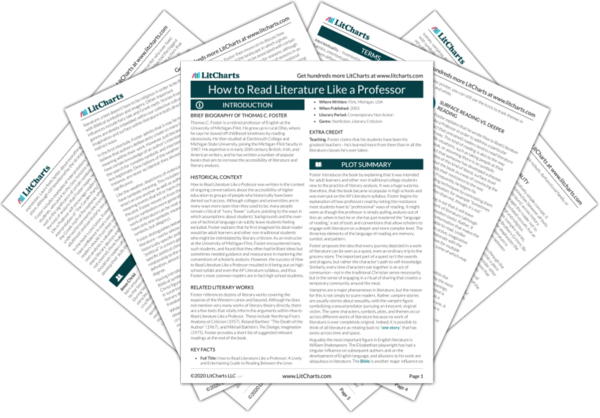Summary
Analysis
Foster argues that there is “no better, no more lyrical, no more perfectly metaphorical illness than heart disease.” Once again, this is of course not true in real life, but it is certainly true of literature. Part of the reason for why heart disease is considered lyrically and symbolically powerful is because, since at least the Ancient Greek era, the heart has been considered the emotional centre of the human body. Endless writers invoke the heart in this context, and the heart is associated with romantic love everywhere from poetry to popular culture. As a result, heart disease symbolizes all kinds of suffering: loneliness, cruelty, cowardice, and so on.
Although science has now confirmed that the heart has nothing to do with human emotion (considering our consciousness lies in the brain), this has done little to decrease the association between the heart and romantic love. Indeed, examples such as Valentine’s Day, the concept of being heartbroken, and countless other cultural conventions show that the heart is still the first thing we associate with love. Such is the enduring power of symbol in the human imagination!
Themes
Heart trouble doesn’t always have to be in the form of disease—in Nathanial Hawthorne’s “The Man of Adamant” (1837), a misanthropic man moves into a cave to escape society, and his heart eventually turns to stone. Meanwhile, the overly-emotional and romantic titular character of Joseph Conrad’s Lord Jim (1900) is killed by being shot in the heart.
As these examples show, characters in literature are punished both for being too loving and not being loving enough. This paradox suggests that part of the role of literature is to teach us to achieve moral and emotional balance in our lives.
Themes
Of course, heart disease isn’t the only illness featured in literature, and different illnesses tend to have their own particular group of associations. Strange as it may sound, some writers return to the same illnesses throughout different works of literature, such as James Joyce’s thematic obsession with paralysis.
Illness is one of the most dramatic parts of life, which makes it ideal fodder for writers. Even painfully slow, drawn-out illnesses have the capacity to drastically alter people’s personalities, behavior, and experience of the world, and as a result illness is a perfect way to propel plot momentum.
Themes
Bear in mind that prior to the 20th century, disease was very mysterious. People did not have a clear understanding of what caused illness, how it would progress, or how it could be cured. Historical context is also relevant to which diseases are more commonly represented in literature. Tuberculosis (or “consumption”) seems to be everywhere in literature, but venereal diseases are almost nowhere to be found. This is partly because of taboos surrounding sexuality, but also because to qualify as a suitably literary illness, a condition should both be “picturesque” and emerge in a mysterious way. Finally, the disease must have strong symbolic potential; this is certainly true of tuberculosis, which causes sufferers to literally “waste away” in front of you.
Like the seasons and weather, illness has historically been difficult for people to comprehend. As a result, writers and artists have developed myths and symbolic explanations to account for the complex, mysterious, and ruthless workings of the human body. As Foster’s words suggest, some writers have had a tendency to romanticize illness, turning it into archetypes such as the frail, feminine victim of consumption. Of course, these figures do not accurately represent the grim reality of the disease.
Themes
Get the entire Read Like a Professor LitChart as a printable PDF.

Indeed, the potential of illness to carry symbolic meaning is arguably the most important reason for how and why illness will appear in a text. Although symbolic meaning is never fixed, illnesses do have particular associations that will be better suited to some narratives than others. The bubonic plague, for example, invokes themes such as all-encompassing tragedy and apocalyptic devastation. Meanwhile, hereditary conditions point to intergenerational tensions, unhappy families, and “parental misdeeds.”
Some people—most famously Susan Sontag—argue that the symbolic role illness plays in literature has had the negative effect of creating the impression that illness in real life is also filled with symbolic meaning. According to Sontag, this can lead us to subconsciously believe that sufferers did something to deserve their illness, or that it is within their power to cure themselves.
Themes
Illnesses play different roles in different eras. Whereas tuberculosis cast a large shadow in Victorian times, the era from the 1980s to the present has been particularly affected by the sudden emergence of AIDS. According to Foster, “AIDS is the mother lode of symbol and metaphor,” and, accordingly, much literature has been produced about the disease. Because of the way the AIDS crisis played out, and the fact that minority groups such as gay men, trans women, and black people were disproportionately affected, the literature of AIDS is also inherently political.
Although the abundance of beautiful art and literature produced in response to the AIDS crisis could never make up for the senseless devastation caused by the disease, this is an important example of the way that people process the darker aspects of existence through literature. When emotions like those generated by AIDS cannot be adequately communicated through normal language, sometimes symbolic language provides a way forward.
Themes
Frequently, writers simply invent illnesses without clearly defining them, and use this as a way to kill off characters with little explanation. Of course, this has been more difficult to do in the era of modern medicine, when mysterious illnesses (mostly) no longer appear out of nowhere.
This passage demonstrates that the boundaries of realism change as our understanding of the world changes. Whereas it would be completely normal for a character to suddenly die of a mysterious illness in a 19th-century realist novel, this would be less realistic in today’s world.
Themes












